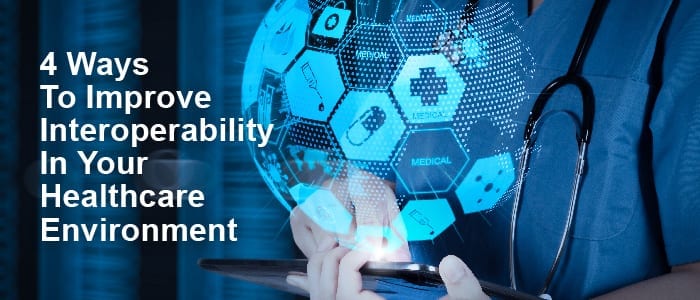4 Ways to Improve Interoperability in Your Healthcare Environment
Interoperability is the hot topic in the healthcare industry this year. The ability for organizations to quickly and securely share patient information and allowing associated organizations involved to assist the patient better is extremely powerful.
An agile data center equipped for interoperability allows you to plan and start using technologies which fit your current demands, while also building a framework to scale and meet future requirements.
Here are 4 ways your organization can improve interoperability.
1. Risk Management
When multiple organizations share a patient’s files, the threat of an attack (such as a hack or data breach) becomes much more dangerous, as it reaches all parties involved.
If one organization in an interoperable is hacked, the hacker may be able to steal patient files from all the healthcare providers within the interoperable.
Planning against hacks and other data breaches is important. However, with the increased risk involved with an interoperable system, each organization should take more precautions.
An organization needs a plan to manage hacking attempts, phishing, malware attacks, and other kinds of malicious intentions aimed at your organization. A key component of a risk management plan is the proper tools to establish a solid baseline of defense against potential threats. Creating procedures and documenting disaster recovery responses is essential.
2. Power Optimization
Often, we take the electricity/power side of technology for granted. Plug in the machine and everything’s ready to go, right? This might be true in a domestic setting, but healthcare equipment can be much more complicated. Power failure in a healthcare setting can be catastrophic.
Poor power quality, installation errors, and grounding issues can impact the operation of sensitive imaging equipment, resulting in costly unplanned equipment downtime, or worse, poor image quality. The later can impact the interpretation of a patient’s condition and potentially place the patient at risk. To avoid this, careful power management is essential.
A) Visibility of performance
The first important factor for power optimization is being able to see where your system is performing at suboptimal levels. Establishing visibility through the entire power chain is essential as it allows “tuning” of the system, raising the overall efficiency.
Our full suite of monitoring and management equipment provides complete solutions for your system. Check them out here.
B) Power Equipment & Server Virtualization
Additional technologies which are important are high-voltage power equipment and server virtualization. These can take your power system to new heights, increasing load while reducing strain throughout the system. You can learn more about server virtualization in this article.
C) Scalability
The final tip for power optimization is the most important: the beginning. Creating a system which can scale with your organization in real time based on incoming demands is crucial. This may require more upfront capital investment but will save you big time later down the road.
Edge Data Centers are a great example of how to do this correctly. Built custom from the ground up, Vertiv can create the perfect solution for your data center needs anywhere in the world.
3. Thermal Efficiency
This section is just for the IT folks designing the data center. We know how essential it is to keep servers cool. A lack of preparation in the cooling system can result in catastrophic equipment damage later due to overheating.
Data centers are now being designed to grow with the business from day one. They are setup to cut costs and improve equipment reliability while supporting growing business demands. This includes the cooling system which is setup to scale as technology, and thereby heat, in the data center increases.
There are three major areas of a data center to consider when designing the cooling system:
There are multiple styles of cooling, and each style has its benefits and drawbacks, but no single method is necessarily more efficient than the others. Any system can be made efficient with proper airflow management.
4. DCIM
DCIM, or Data Center Infrastructure Management, provides your IT staff a complete picture of the current state of the data center. They deliver actionable and intelligent insight to drive your system’s energy efficiency while helping you strategically plan for future capacities. Space, power, and cooling resources are all included in the consideration of DCIM systems.
DCIM systems help data center managers:
- Execute technical and business goals and changes
- Reduce waste and unnecessary over-provisioning
- Plan for new data center capacity through forecasting
- Decrease downtime risks
- Increase energy efficiency
Check out our DCIM Solutions for Monitoring and Management.
Need Help Optimizing Your Healthcare Environment?
Vertiv is 100% focused on your data center reaching its full potential. If you need the technology discussed above or help managing, building, or expanding your data center, we’re here to help.
Contact your local Vertiv office today to get started!

